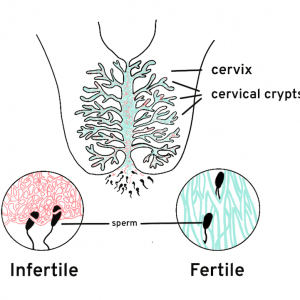What is cervical fluid?
Cervical fluid, often known as cervical mucus, is a hydrogel produced by the cervix. It contains mucus molecules, protein chains, minerals, and water – lots of it. When combined, this allows the vaginal fluids to form a unique electrolyte structure that changes throughout the menstrual cycle.
During the first half of the cycle, rising estrogen levels cause the glands of the cervix to secrete fluid.
The consistency and color of cervical fluid varies — from clear to watery, for example. When observed, it could look like raw egg white or sticky like glue stuck on your underwear.
This is all healthy, normal, and a key sign to unlocking your fertility.
In a healthy cycle, you will start to see cervical fluid for an average of 5 days before ovulation. Ovulation means that the egg is released from the ovary. After ovulation occurs, your body will start to release the hormone progesterone, causing the mucus to thicken and form a rock wall type barrier. From the outside, it will seem like things “dried up,” in a sense. This stops sperm (and any foreign substance) from getting through the uterus. Your cervix will stay closed off until your period arrives and the whole cycle starts again. Voila!
Note that other fluid patterns are possible, particularly if you are experiencing changes in your cycle patterns due to stress, intake of hormonal birth control or other medications, hormonal issues such as PCOS, breastfeeding, or perimenopause.
Is cervical fluid really worth monitoring?
Did you know that ovulation only happens within one day in the entire cycle and, once the egg is released from the ovary, it only has 12 to 24 hours to be fertilized? With such a short ovulation period, it seems impossible humans can get pregnant at all!
The reason we’re fertile for longer than 24 hours is because of the nectar of fertility: cervical fluid. Cervical fluid extends that small window of fertility to approximately 6 days of your cycle. With the help of cervical fluid, sperm can be kept alive for up to an incredible 5 days!
Contrary to popular belief, a woman is not always fertile. Outside of this 6 day fertile window, pregnancy is not possible.
Cervical fluid plays a critical role in fertility and pregnancy because sperm cannot survive in the vagina unless cervical fluid is present.
In order for conception to occur, cervical fluid and sperm must go through an elegant dance together. We like to think of it as a love–hate relationship.
Here’s 4 ways cervical fluid and sperm interact:
1. Cervical fluid makes the vagina a sperm-friendly place
Naturally, the vagina is a hostile place for sperm due to its acidity (pH 4.5). Semen can only live in a milder pH between 7.2 and 8.4, which is a more basic environment. An acidic vaginal environment is helpful for killing harmful bacteria and preventing infections, but, it also prevents sperm from swimming up the reproductive tract. Once you enter your fertile window, the cervical fluid changes the pH to 7.9 which is more alkaline, or non-acidic, and actually helps keep the sperm alive.

2. Cervical fluid provides the necessary nutrients and energy for sperm to meet the egg
Cervical fluid has high water content, often exceeding 96% water. With the help of cervical fluid and it’s high water content, often exceeding 96% water (Katz et al., 1997), the pathway to fertilize an egg is more accessible. Imagine going down the waterslide with no water flowing. Ouch.
More amazingly, cervical fluid is rich with nutrients that the spermatozoa need to stay alive and have the energy to keep those tails swimming!
Pro tip: If you’re trying to conceive: sex on the day of maximal cervical fluid stretch (aka hydration) is most likely to be successful in timing intercourse for achieving pregnancy. This is even more accurate than using temperature shifts (which occur after ovulation), the calendar method or ovulation prediction kits.
3. Filters out abnormal sperm
When it comes to the 180 million sperm released in an ejaculate, it means survival of the fittest!
Doesn’t this make sense? We don’t want just any weak sperm reaching that one precious egg.
Sorry guys, but sperm with curved, irregular, or otherwise awkward swimming patterns who enter will find themselves pretty much stuck.
Most of the tens of millions of tiny swimmers don’t make it pass the uterus and into the fallopian tubes. It takes 5 to 68 minutes for the sperm to get to the point where they need to go to fertilize the egg. The journey is long and complex, many sperm die along the way, some sperm are mutated or abnormal (like have 2 heads and maybe abnormal genetic material).
Why don’t they make it? It’s not just the long journey but it’s, you guessed it, the cervical fluid! Cervical fluid, in the fertile window, actually forms channels that the sperm have to navigate through.
These cervical fluid channels filter out the bad sperm (like the sperm with two heads and poor genetic content, for example). HOW AMAZING IS THAT?
Cervical Mucus in Infertile Phases
- Creates a cervical plug
- Acidic pH that is not favourable to sperm survival
- High electrolyte levels
- Acts as a physical barrier
- Sperm die shortly after ejaculation
- No cervical mucus is visible
Cervical Mucus In Fertile Phases
- Forms channels that allow sperm to reach the cervix
- Alkaline PH making it sperm-friendly
- Low electrolyte levels
- Capacitates and nourishes sperm
- Allows sperm to live in the cervix for roughly 5 days
- Cervical mucus is visible at the vulva
Benefits of tracking your cervical fluid
According to one study, only 12.7% of people seeking fertility treatment can accurately identify their fertile window. With the knowledge you gain from tracking cervical fluid, you can proactively take charge of your reproductive health with less dependency on medical intervention.
Cervical fluid can allow you to identify:
- when you’ve entered your fertile time
- when you’ve exited it (unlike the second most important sign of fertility, basal body temperature, which can only confirm you’ve exited your window).
- Peak fertile days so that you can optimize your chances of conception.
Mapping the changes of your fertility’s key biomarker, the fertility nectar, can help give you insight into your hormonal balance, stress levels, reproductive health, and underlying medical conditions.





